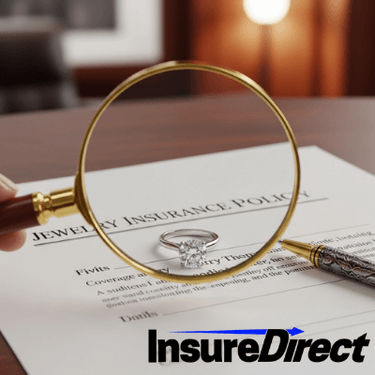I never thought too hard about jewelry until I nearly lost my engagement ring once at the grocery store. Panic set in fast. That’s when it hit me—maybe jewelry insurance isn’t something only wealthy collectors worry about. Truth is, anyone can need it, and most people don’t realize until it’s too late.
Okay, so what exactly is Jewelry Insurance?
Simple words: it’s protection for your rings, bracelets, earrings, watches, or whatever valuable piece you got. Not the same as the tiny coverage you find in a normal home insurance plan. That’s usually capped low—like one or two thousand dollars, sometimes less. Jewelry insurance is its own thing, built to replace or repair what you lose or break.
Imagine a stone falling out of your ring, or a necklace slipping off at the beach. Or worse: stolen right from your hotel room while traveling. That’s the kind of nightmare this policy covers.
But Why Bother With It Anyway?
I’ll be straight—jewelry is easy to steal, harder to keep safe, and unbelievably expensive to replace. I read somewhere jewelry counts for nearly a third of property crimes. If you think about it, makes sense: tiny, shiny, portable. Perfect for thieves.
And here’s the kicker. If it’s gone, it’s gone. Police reports won’t bring back your grandmother’s pendant or a Rolex. Without insurance, you’re stuck with heartbreak and a big hole in your wallet. That’s why people like me started paying attention.
So Who Should Really Think About It?
Engaged or Married Folks
Let me start obvious. Engagement rings. Wedding rings. They ain’t just jewelry, right? They’re memory, love, milestones. Dropping it down a drain or losing it at the gym is devastating. If you’re planning marriage or already tied the knot, this is one type of insurance you shouldn’t skip.
Jewelry Collectors
There’s people who collect cars, and then there’s those who collect diamonds. If you’re one of the second group—yeah, you need coverage. Because most standard homeowner’s plans don’t cover your $10,000 necklace or your $20,000 watch. That little “coverage cap” clause hides in fine print. A proper jewelry insurance policy actually lists each item with its value.
Family Heirloom Holders
I’ll tell you the truth—my mom gave me a small gold chain from her side of the family. It’s not worth much in money, but it means everything. Stuff like that, you can’t truly replace. Insurance won’t bring grandma’s actual necklace back, but at least you’re not left empty-handed financially. Better something than nothing.
Travelers (Like Me Sometimes)
Anyone who takes jewelry on trips… oof, the risks. Airports, taxis, hotels, beaches—you name it. The number of ways to lose jewelry on the move is endless. If you’re the type who wears your favorite ring everywhere, don’t rely on homeowner’s coverage. Travel puts you in situations where stuff just “vanishes.” Insuredirect jewelry insurance usually works worldwide, which is why it makes sense.
People Living Where Break-Ins Happen
I used to live in a busy city block where burglary was normal dinner table talk. Break-ins every few weeks. If your area feels anything like that, why leave valuables vulnerable? A thief doesn’t care how special your watch is. Jewelry insurance at least gives you a fighting chance to recover financially.
Luxury Watch Owners
This one deserves its own point. Rolex, Cartier, Omega, Patek—these are investments, not just “time keepers.” Thieves love them because they’re small, easy to sell. If you’re rocking one of those on your wrist daily, you’re a target whether you know it or not.
Everyday Jewelry Wearers
I got friends who never take off their rings. Sleep in them, shower in them, everything. If that’s you, the chances of accidents multiply by a lot. Daily wear = daily risk. Insurance fills the gap between “oops, I chipped the diamond” and “I lost the whole thing at the park.”
The Money Side: How Much It Costs
When I first checked, I was surprised. It’s not crazy expensive. Usually about one to two percent of the piece’s value every year. Which means:
$5,000 ring → around $50–$100 yearly.
$15,000 watch → maybe $150–$300 annually.
Not bad when you compare it with the thousands you’d spend replacing it yourself. Of course, the price shifts based on city crime rates, deductible, appraisal, and your insurance company’s quirks.
Getting Jewelry Insurance: The Basics
What I did (and you should too, if you’re considering it):
Get it appraised. A jeweler gives the official value. Without that, you’re guessing.
Pick your path. Either add a rider to your home/renter’s policy or grab a insuredirect jewelry plan.
Read carefully. Some cover worldwide loss, some don’t. Some cover “mysterious disappearance” (aka: no clue what happened), others skip it.
Keep records. Receipts, photos, certificates—don’t toss them. Insurance companies love paperwork.
My Closing Thoughts
Do you need jewelry insurance? Maybe not everybody. But if you own something you’d be heartbroken—or broke—without, yeah, you probably do.
Think about it like this: jewelry isn’t just metal and stone. It’s love, family, status, investment. Things you don’t want to lose forever. The world’s unpredictable. Theft, accidents, simple clumsiness—whatever. Insurance won’t give you back the exact ring or watch, but it softens the blow big time.
At the end of the day, I’d rather pay a small yearly fee than stare at an empty ring finger wishing I had done something sooner.
Looking for the best insurance coverage? InsureDirect has you covered. Getting a home insurance quote is fast and hassle-free.
Visit us online or reach out to our corporate office:
InsureDirect.com
Corporate Home Office
618 South Broad Street
Lansdale, Pennsylvania 19446
Email: contact@insuredirect.com
Phone: (800) 807-0762 ext. 602
Protect your home and enjoy peace of mind with InsureDirect—because your home deserves nothing less.

